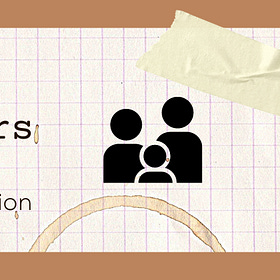👮CCE in the Background: 3 Warning Signs to Watch For in September
Subtle signals. Significant risk. What you might spot before the referral.
👋 Welcome to SEMH Education!
Every week, I share insights, strategies, and tips from my experience working with children and professionals on social, emotional, and mental health (SEMH) in education. This week, we’re exploring Child Criminal Exploitation and some signs you can look out for!
September brings sharpened pencils, new uniforms, and, for some pupils, a quiet return from an unsafe summer. While we refocus on routines, classroom displays, and getting names right, CCE doesn’t take a break. It’s often not loud or dramatic. In fact, some of the most concerning signs of grooming and exploitation in children and young people are subtle, especially when they’ve been coached to hide them.
This post isn’t about heavy safeguarding theory. It’s a gentle but important prompt: three often-overlooked signs of CCE that teachers and school staff may notice in the first few weeks back. Especially helpful for tutors, classroom teachers, DSLs, and pastoral leads.
🙇 1. Over-apologising or Excessive Deference
"Sorry, sir. Sorry. I didn’t mean- sorry."
We often associate exploitation with defiance or aggression, but many exploited children show the opposite. They may become unusually compliant, overly polite, or quick to take the blame. This isn’t just a personality trait. It can be a learned survival strategy after a summer of coercion and control.
Why it matters:
CCE can involve grooming tactics that condition children to obey without question. A pupil returning in September who’s suddenly much more submissive, quieter, or scared to "cause trouble" might not just be maturing; they could be navigating fear or control from an external source.
What to do:
Note sudden changes in behaviour, especially toward authority figures.
Ask yourself: “Is this new for them?” or “Does this feel disproportionate?”
Log and monitor. One small shift won’t trigger a referral, but a pattern might.
Quietly build trust, avoid spotlighting or praising compliance in front of peers.
🔀 2. Change in Peer Group or Unexplained Older Associates
"He’s hanging out with lads in Year 11 now. They wait for him at the gate."
Most schools look closely at peer-on-peer dynamics, but we sometimes overlook unusual relationships across age brackets, particularly with those outside school. A pupil might start referring to “older cousins” or “mates from another school.” Often vague. Sometimes made up (by this I mean the mates from the school don’t actually go to school anymore as they’re over 18!)
Why it matters:
CCE networks rely on peer grooming, using other young people to pull new ones in. These changes can be masked as "growing up" or finding a new identity, but may actually reflect the pull of criminal influence.
What to do:
Track any sudden shift in peer group or unexplained “friendships” with older students.
Look for patterns: Who’s picking them up? Who are they messaging at lunch?
DSLs should consider home visits (with consent) or checking police intelligence via your Safer Schools Partnership.
📑 DfE Link: The Keeping Children Safe in Education (KCSiE) 2024 guidance emphasises the importance of noticing changes in friendship groups as a potential red flag for exploitation.
🗓️ 3. Increased Absences on Mondays or After Holidays
"He’s always ill after a weekend. Every time."
This one’s deceptively simple. But patterns of non-attendance, especially after weekends, bank holidays, or half-terms, can sometimes reflect more than disengagement or sleep issues. It may indicate involvement in county lines activity, where children are often moved or tasked during “quiet times” when they’re less likely to be noticed.
Why it matters:
CCE doesn’t always show up as truancy across the week. In fact, many children being exploited still want to come to school, as it feels safer than wherever they’ve been.
What to do:
Monitor absence patterns with your attendance officer or pastoral lead.
Ask: Is this pupil consistently absent after time away from school?
For pupils with EHCPs or SEMH needs, be mindful that these patterns may be wrongly attributed to anxiety or avoidant behaviour alone.
Policy reference: The DfE’s Working Together to Improve School Attendance (2024) includes CCE as a legitimate factor contributing to vulnerability in persistent absenteeism.
“Recognise children missing education can act as a vital warning sign to a range of safeguarding issues including neglect, sexual abuse and child sexual and criminal exploitation.”
📣 What Next? A Gentle Call to Action
You don’t need to jump to a referral every time you spot one of these signs. But you do need to stay curious. Keep your safeguarding radar on, and trust your professional instinct when something feels off.
If you're unsure:
Check in with your DSL.
Keep records.
Talk to colleagues, a shared concerns paint a clearer picture.
Revisit your school’s or local authorities’ CCE training or access your local safeguarding partnership’s update.
🧠 Final Thought
In the first few weeks of term, we’re often focused on relationships, routines, and readiness. But let’s not forget: some children are returning to school from a very different kind of summer. They won’t always tell you. But their behaviour might.
Keep your eyes open. You could be the first safe adult to notice!
📬Did You Miss These?
🧠 Why Mental Health Training Matters for Every Educator
I’m not advocating for every member of school staff to become experts in mental health here. However, I am advocating for more awareness around mental health from every staff member in school. There’s been an increase in children experiencing mental health problems in England. Schools should be safe places where staff can readily offer support and strategies to children. It’s not rocket science, and you do a lot of this already!
✋ Challenging Discrimination
We don’t always realise how early children start forming views about the world and how powerful social media can be in shaping them. Scrolling through TikTok or YouTube Shorts, young people absorb an endless stream of content that doesn’t just entertain but subtly reinforces ideas about what’s “normal,” acceptable, or worthy of ridicule. Messages about masculinity, femininity, race, sexuality, and gender identity are everywhere, often unfiltered, unchallenged, and algorithmically amplified.
Importance of Parents in Education 🏫
SEMH pupils often face significant challenges that make their educational journey more complex. These students need comprehensive support not just from teachers, but also from their families/carers. Effective communication with parents/carers is essential in providing that support





